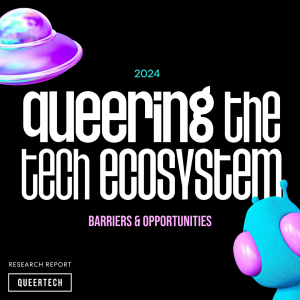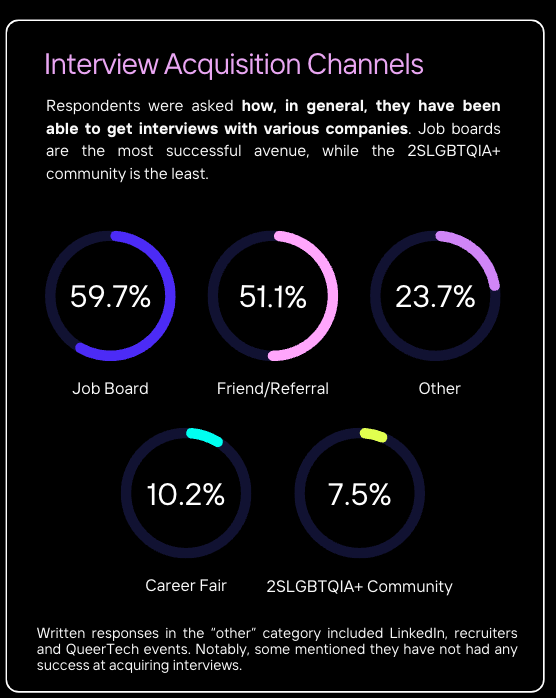|
Getting your Trinity Audio player ready...
|
We have all seen rising anti-2SLGBTQIA+ hate in Canada and abroad; this sentiment lives in discussions surrounding trans athletes, queer refugees, drag performers and rampant rates of online abuse. This growing intolerance has solidified as hate-fuelled legislation, organized protests and sobering rates of targeted violence – evidenced by a 64% increase in hate acts against this community from 2020 to 2021.
Historical and contemporary discrimination against 2SLGBTQIA+ Canadians has led to inequitable socio-economic outcomes. In the workplace, we see these disparities manifest in several ways – from glaring underrepresentation in our workforces, to high rates of targeted harassment toward existing queer employees.

While diversity, equity and inclusion (DEI) has been a popular topic of discussion within business ecosystems since the 1960s, tailored 2SLGBTQIA+ inclusion efforts lag considerably. One key reason for these shortcomings is a stark lack of applicable data; if employers and career professionals don’t have visibility into the scope and nuances of a problem, they will be hard-pressed to develop impactful solutions.
This is why QueerTech prioritized the development of the Queering the Tech Ecosystem: Barriers and Opportunities Research Report – a research initiative three years in the making that chronicles and quantifies the lived experiences of 2SLGBTQIA+ Canadians in the technology industry. As a high-potential area for intervention and advocacy, the report focuses heavily on recommendations to improve inclusion within recruitment and hiring processes. Like any underrepresented group, 2SLGBTQIA+ candidates and employees have unique lived experiences and needs that deserve to be considered by their employer. Here are a few ways we can start:
1. Employer Brand & Job Postings
A common theme throughout our research interviews was the notion of 2SLGBTQIA+ jobseekers being hyper-aware of subtle exclusive cues within a company’s brand or within the job posting. This awareness is a way for potential applicants to protect themselves. Meaning, if a potential applicant believes they may encounter judgment or discrimination while engaging with your company, they are unlikely to apply in the first place.
| Barrier | Recommended Action |
| Queer jobseekers are at a heightened risk of emotional distress and mistreatment in unknown environments. | Ensure your marketing materials and employer brand assets reiterate a genuine commitment to inclusion. Prioritize transparency and accountability in these assets, while also ensuring you show your organization’s commitment to DEI – via informed vocabulary and representationally balanced visuals. |
| Queer individuals may have distrust in institutions such as corporations, banks and government agencies. | Establish the company as an equal-opportunity employer and develop effective systems for candidate self-identification. Whenever possible, display how these policies work in tandem with inclusion efforts across the organization. |
| Nobody wants to be hired solely based on their identification with a marginalized community. | In your marketing and storytelling efforts, reiterate why your company has DEI goals (i.e. impact, innovation and problem solving versus optics). |
2. Candidate Vetting & Selection
When approaching equity and inclusion within the recruitment and hiring process, we must do the foundational work of unlearning toxic narratives, challenging our conscious and unconscious biases, and implementing mechanisms to encourage objectivity. Over time, these practices will lead to a growing influx of diverse talent into our workforces.
| Barrier | Recommended Action |
| Due to inequitable access to opportunities, queer individuals often display less “prestigious” CVs than their non-queer counterparts.
Humans are, largely, incapable of correcting their own internal opinions and are likely to display confirmation bias. |
Use anonymous CVs for the first round of candidate evaluation to mitigate potential biases against (or for) certain candidates. |
| Underrepresented communities are subject to data and modelling discrimination within emerging technologies, such as artificial intelligence. | Review, if applicable, biases in AI candidate sorting systems to ensure equitable, diverse outputs. |
| Queer individuals have unique advantages as employees, but these advantages are not regularly accounted for during candidate selection. | Restructure hiring criteria, in collaboration with experts, to incorporate intersectional frameworks and systems to quantify the value of diverse candidates. |
3. The Interview Process
Our research found that over 35% of respondents have experienced blatant discrimination during at least one interview, with another 9.5% thinking they have but can’t be sure. These worrying findings indicate the continued presence of systemic bias, and human error, within our interview processes.
| Barrier | Recommended Action |
| Queer candidates, and multiply-oppressed candidates, regularly experience being the only diverse individual in a room. This can lead to said candidate feeling uncomfortable and their worth being unrecognized. | Ensure your interview team has representational balance from underrepresented communities. This should be a mandated requirement for all interviews, every time, regardless of the interviewing candidate’s identity. |
| Queer candidates do not have visibility into the inner workings of the company. They may fear a toxic culture, targeted harassment or company apathy. | Relay DEI policies and accountability processes to all candidates, reiterating the company’s commitment to inclusion and the reasoning behind said goal. |
| Many queer candidates are not selected for interviews and are never told why. This discourages them from applying in the future and perpetuates homogenous workforces. | Provide constructive feedback to all unsuccessful, diverse candidates in order to contribute to a greater influx of underrepresented individuals into the workforce over time. |
4. Onboarding Success
When considering topics associated with DEI, discussions surrounding recruitment and hiring typically overpower discussions of retention and advancement – but they are symbiotic and equally important to consider.
| Barrier | Recommended Action |
| Queer communities experience barriers that non-queer communities don’t in terms of team building and recreation. | Plan culturally competent team-building activities that reflect an understanding of barriers experienced by underrepresented communities (i.e. avoid intoxicants, the need for personal spending, etc.). |
| It isn’t uncommon for new queer employees to have limited experience and exposure to corporate systems and processes – meaning, many may not be familiar with formalized professional development, HR departments, ERGs (employee resource groups) or similar. | Revisit onboarding processes to ensure concrete support, culturally competent professional development channels and easily accessible accommodations. |
| Queer employees regularly experience lower rates of advancement and promotion than their non-queer counterparts. | Establish multilateral mentor-matching systems in the organization to foster connection, career advancement and skill development. |
5. Performance Metrics & Talent Team Recognition
One crucial, yet often overlooked aspect, of improving inclusion within hiring processes is the work done after a successful placement.
| Barrier | Recommended Action |
| Healthy, actionable data collection surrounding queer inclusion in the workplace is often insufficient in both quality and quantity. | Establish and maintain robust systems for tracking diverse candidates and their journey to employment. Said systems should incorporate qualitative data on candidate sorting and selection, successful versus non-successful placements and feedback supplied through the process. |
| Contemporary DEI strategies are often static and fail to accommodate the nuances of holistic inclusion. | Develop systems to improve hiring processes. For example, the hiring team should meet following a job posting lifecycle to discuss what’s working, what isn’t working and what can be iterated going forward to improve goals surrounding diverse placements. |
| Hiring teams are not properly incentivized, recognized or compensated for their work in progressing DEI goals. | Mandate the successful recruitment, and retention, of diverse employees within the talent team’s success criteria and key performance indicators. Compensation and advancement opportunities should be integrated with said organizational goals. |
Holistic, genuine workplace inclusion efforts cannot exist in silos or be addressed individually. Thoughtful recruitment and hiring processes that contextualize the unique barriers 2SLGBTQIA+ communities face is only one piece of this complex puzzle. Opening the door is one thing, but making queer employees feel safe and respected via informed HR policies and cultural intervention work is another. Diversity, equity and inclusion efforts across a company are just as highly nuanced and evolving as its workforce. It’s hard work, but it’s work worth doing for your people.
To access the Queering the Tech Ecosystem: Barriers and Opportunities Research Report, visit queertech.info/QueeringTechReport.






